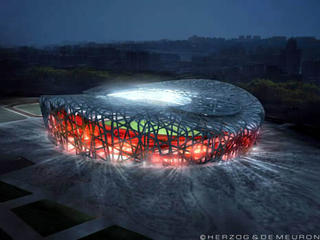Festival Of China -- The Reality Version
"Beijing's new airport is rising from the dry plains east of the city so fast that, in just four years, China will have designed, built and opened a structure larger than all the terminals at Heathrow combined. That's rather less time than the lawyers spent arguing about Heathrow's Terminal 5. 'It's the world's largest and most advanced airport building,' says the project's architect, Norman Foster. With airports at Stansted and Hong Kong already under his belt, he should know better than anyone. But it still looks more like a medieval battlefield conceived on the scale of a Japanese epic, rather than the sleek glass-and-steel bubble shown in Foster's glittering computer renderings. Swarming warrior armies cluster around giant cranes, more than 100 of them, ranged like ancient siege engines across a frontline almost two miles long. The dust swirling across the landscape makes it impossible to count more than a few of them before they disappear into the acrid haze....
'The airport will be the gateway to the city,' says Foster. 'It's advanced not only technologically, but also in terms of passenger experience, operational efficiency and sustainability. It will be welcoming and uplifting, a symbol of place, its soaring aerodynamic roof and dragon-like form will celebrate the thrill and poetry of flight and evoke traditional Chinese colours and symbols.'
In short, the airport is not simply about shifting large numbers of people in and out of the city. Just as important will be its part in the conspicuous assertion of a new kind of China and its modernity. It is one of a dozen huge projects Beijing is building at furious speed to transform the city in time for the Olympic games of 2008....
Beijing is the capital of the world's fastest-growing economy, provoking a titanic struggle between a totalitarian political system and the liberalisation that is the presumed product of its economic transformation. By some estimates, half the world's annual production of concrete and one-third of its steel output is being consumed by China's construction boom...."
Deyan Sudjic "The City That Ate The World" The Observer October 16, 2005.

Herzog & De Meuron's winning - design for Beijing's National Stadium (2008 Olympic Stadium)
"The Swiss firm proposed a seemingly random, lattice-like network of concrete strips forming the stadium's bowl shape, resembling a "bird's nest", in the architect's words. Gaps between the concrete structure would be filled with "inflatable cushions", another phrase the architects used to describe their innovative design."
Credits: Herzog & De Meuron and http://www.archidose.org/
'The airport will be the gateway to the city,' says Foster. 'It's advanced not only technologically, but also in terms of passenger experience, operational efficiency and sustainability. It will be welcoming and uplifting, a symbol of place, its soaring aerodynamic roof and dragon-like form will celebrate the thrill and poetry of flight and evoke traditional Chinese colours and symbols.'
In short, the airport is not simply about shifting large numbers of people in and out of the city. Just as important will be its part in the conspicuous assertion of a new kind of China and its modernity. It is one of a dozen huge projects Beijing is building at furious speed to transform the city in time for the Olympic games of 2008....
Beijing is the capital of the world's fastest-growing economy, provoking a titanic struggle between a totalitarian political system and the liberalisation that is the presumed product of its economic transformation. By some estimates, half the world's annual production of concrete and one-third of its steel output is being consumed by China's construction boom...."
Deyan Sudjic "The City That Ate The World" The Observer October 16, 2005.

Herzog & De Meuron's winning - design for Beijing's National Stadium (2008 Olympic Stadium)
"The Swiss firm proposed a seemingly random, lattice-like network of concrete strips forming the stadium's bowl shape, resembling a "bird's nest", in the architect's words. Gaps between the concrete structure would be filled with "inflatable cushions", another phrase the architects used to describe their innovative design."
Credits: Herzog & De Meuron and http://www.archidose.org/


0 Comments:
Post a Comment
<< Home